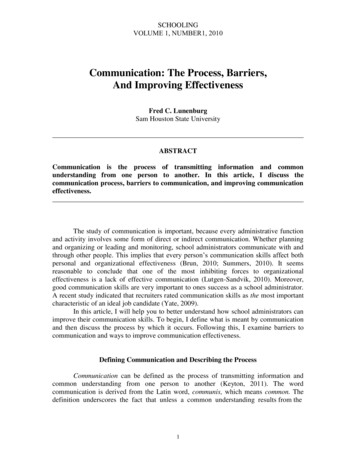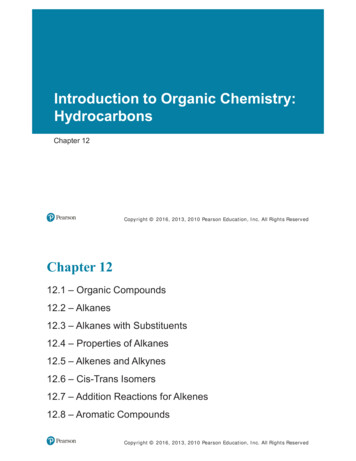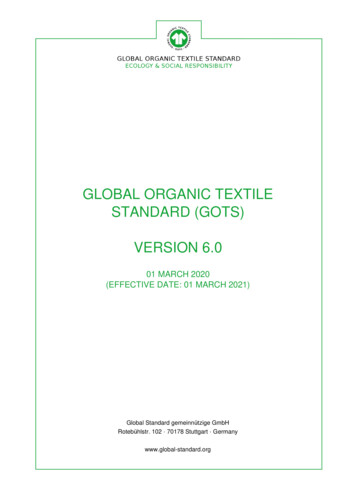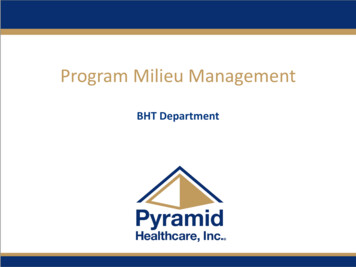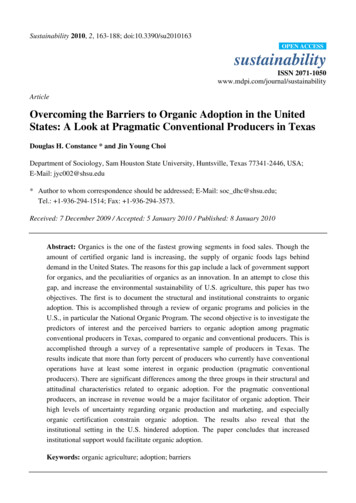
Transcription
Sustainability 2010, 2, 163-188; doi:10.3390/su2010163OPEN ACCESSsustainabilityISSN eOvercoming the Barriers to Organic Adoption in the UnitedStates: A Look at Pragmatic Conventional Producers in TexasDouglas H. Constance * and Jin Young ChoiDepartment of Sociology, Sam Houston State University, Huntsville, Texas 77341-2446, USA;E-Mail: jyc002@shsu.edu* Author to whom correspondence should be addressed; E-Mail: soc dhc@shsu.edu;Tel.: 1-936-294-1514; Fax: 1-936-294-3573.Received: 7 December 2009 / Accepted: 5 January 2010 / Published: 8 January 2010Abstract: Organics is the one of the fastest growing segments in food sales. Though theamount of certified organic land is increasing, the supply of organic foods lags behinddemand in the United States. The reasons for this gap include a lack of government supportfor organics, and the peculiarities of organics as an innovation. In an attempt to close thisgap, and increase the environmental sustainability of U.S. agriculture, this paper has twoobjectives. The first is to document the structural and institutional constraints to organicadoption. This is accomplished through a review of organic programs and policies in theU.S., in particular the National Organic Program. The second objective is to investigate thepredictors of interest and the perceived barriers to organic adoption among pragmaticconventional producers in Texas, compared to organic and conventional producers. This isaccomplished through a survey of a representative sample of producers in Texas. Theresults indicate that more than forty percent of producers who currently have conventionaloperations have at least some interest in organic production (pragmatic conventionalproducers). There are significant differences among the three groups in their structural andattitudinal characteristics related to organic adoption. For the pragmatic conventionalproducers, an increase in revenue would be a major facilitator of organic adoption. Theirhigh levels of uncertainty regarding organic production and marketing, and especiallyorganic certification constrain organic adoption. The results also reveal that theinstitutional setting in the U.S. hindered adoption. The paper concludes that increasedinstitutional support would facilitate organic adoption.Keywords: organic agriculture; adoption; barriers
Sustainability 2010, 21641. IntroductionDespite the potential for organic agriculture to improve the environmental performance of U.S.agriculture [1-8], the national standard is having only a modest impact on environmental externalitiescaused by conventional production methods because the organic adoption rate is so low [9]. Organicfood is one of the fastest growing segments is food sales, and in recent years the organic food sectorhas experienced double-digit growth, while conventional foods have experienced a more moderate 2to 3 percent growth rate [10-12]. Once considered a niche-market, organic products are now sold in themainstream supermarkets as the majority of U.S consumers buy some organic products [13]. Whileover the past 20 years U.S organic production has more than doubled, consumer demand has increasedat an even faster pace. Although the U.S. Congress passed legislation in 1990 to regulate organics andthe National Organic Program (NOP) was created in 2002, the adoption of and conversion to organicpractices has not kept up with demand. As a result, organic foods and food supplies that meet theUSDA regulations are being imported to supply the growing demand in the U.S. In an attempt to closethe gap between domestic production and consumption, the Food, Conservation, and Energy Actof 2008 (2008 Farm Act) included several new provisions to increase organic adoption rates [9].In support of efforts to close the gap between organic consumption and production in the U.S, andthereby contribute to the environmental sustainability of U.S. agriculture, this research followsPadel’s [14] suggestion and pursues two complementary objectives. According to Padel [14], toincrease rates of organic farming adoption, research needs to go beyond the personal characteristics ofconventional farmers interested in organic adoption and investigate the structural and institutionalframework of adoption. Accordingly, the first objective of this research is to document the structuraland institutional constraints to organic adoption in the U.S. This is accomplished through a review ofthe development of organic initiatives, programs and policies in the U.S., focusing on the NOP createdin 2002. The NOP, and its protocol for the USDA certified-organic label, is the only governmentsanctioned measure of sustainable agriculture in the U.S. The second objective is to investigate thepredictors of interest and the perceived barriers to organic adoption among pragmatic conventionalproducers in Texas, compared to organic and conventional producers. This is accomplished through asurvey of a representative sample of producers in Texas. Focusing on producers who operateconventional operations in Texas who indicate an interest in organic production, what someresearchers call ―pragmatic conventional‖ producers [15,16], the paper documents predictors of suchinterest and investigates the perceived barriers to the adoption of organic production methods.The paper begins with an overview of the development of organics in the U.S., focusing on thestructural and institutional context of this development, including some comparisons to similar eventsin Europe. The next section reviews the literature on barriers faced by conventional producers to theadoption of organic farming methods, focusing on the peculiar aspects of organics as an agriculturalinnovation. The next section reports the research project carried out in Texas. Finally, the discussionand conclusion sections provides some analysis of the situation facing potential organic adopters inTexas and the U.S., and some policy prescriptions designed to facilitate increased organic adoption.
Sustainability 2010, 21652. Background on Organics in the United StatesGrowing at a rate of between 12 and 21 percent annually, the market for organic foods in the U.S.has quintupled since 1997, increasing from 3.6 B in 1997 to 21.1B in 2008 [17]. Organic foods nowaccount for 3% of total U.S. food sales and are expected to grow at similar rates for the next fewyears [12]. At the global level, organic sales doubled from 2000 to 2008 to 38.6 B, and are increasingat a rate of about 5 B per year [18]. The vast majority of these products are consumed in the U.S. andEurope, followed by Japan.The growth in organics has attracted entry by both large conventional farming operations to meetthe demand [19], as well as the mainstream supermarkets to retail to customers [9,20]. As a result, theorganic distribution system is rapidly transforming from one characterized by the domination of directsales and specialty/natural food stores to incorporation into the conventional system [12,21]. By 2006mass market grocery stores such as WalMart and Kroger accounted for the 38% of organic food sales,with another 8% through mass merchandisers and ―club‖ stores [22]. Significant entry into theorganics market is expected to continue [12].Table 1. U.S. Organic Certified Farm Operations: 1992–2007; Certified Organic Farmland:1992–2005 (in thousands of hectares) and Certified Livestock: 1992–2005 (in thousands).Item19921997200220052007% change92–9797–0202–0502–07Operations*3,587 5,021 7,323 8,493 10,159 40461639FarmlandTotal378.6 544.9 779.2 1640.84543111Pasture/rangeland215.3 200.9 253.3 943.4–726272Cropland163.3 344.0 525.9 697.41115333AnimalsLivestock11.618.5108.4 196.65948581Poultry61.4 798.3 6,270.213,757.31,201685119* Does not include subcontracted organic farm operations. Source: USDA/ERS [11], Table 2 and Table 4:based on information from USDA-accredited State and private organic certifiers.At the production level, data in Table 1 reveal that the amount of certified organic land in the U.S.doubled between 1992 and 2002 and then doubled again by 2005. Over the period 1992–2005,livestock, especially poultry, has increased more rapidly than crop and pasture land, and within thefarmland category, most of the increase is in pasture. Notice that while the increase in the number ofcertified-organic operations was greater in the 2002–2007 period than in 1997–2002 period (2,836and 2,302, respectively), the percentage increase was lower (39% and 46%, respectively).Acknowledging that care must be taken in comparing growth trends for different timeperiods (2002–2005 for farmland and livestock versus 2002–2007 for operations), it appears thatproduction levels have increased more rapidly than number of operations since the creation of the NOPcertified-organic standard in 2002.
Sustainability 2010, 2166By 2007, a total of 32.2 M hectares were certified as organic worldwide, 1.5 M more hectares thanin 2006 [23]. Although the amount of certified-organic land is increasing in the U.S., the rates acrosscommodity sectors vary greatly. For example, in 2005 only about 0.5% of cropland (0.2% of soy andcorn) and pasture were certified, but almost 5% of vegetable land and 2.5% of fruit and nut land werecertified [24]. In 2008 organic production has spread to every state and every commodity sector [11] inthe U.S. At the global level, in 2007 the U.S. was tied for fourth largest (1.6 Mha) in terms of amountof agricultural land certified organic or ―in transition‖ to organic, following Australia (12.0 Mha),Argentina (2.8 Mha), Brazil (1.8 Mha) and China (1.6 Mha) [18]. Even with the steady increases inorganic production in the U.S., domestic supply still lags substantially behind domestic demand [9].Undersupply is most evident in the North American region [24]. While lack of consumer demandfor organics was cited as the limiting growth factor in the U.S. in the early 1990s [25,26], by thelate 1990s the lack of sufficient quantity and quality supply of organic products became theproblem [27]. Now, as organics is embraced as a lucrative opportunity by mainstream food companiesthrough both internal development and acquisition of existing organic companies, a lack of reliableaccess to supplies of organic raw materials is reported as the factor limiting business growth [9,12,28].Although the U.S. had been a net exporter of organic foods for many years, by 2002 organicimports greatly exceeded exports (exports were in the range of 125– 250 M while imports were 1.0– 1.5 B) [29-31]. Since 2002, organic imports have increased at even higher rates [9]. TheNational Organic Program (NOP) certified-organic standards created in 2002 allows organic farmersand handlers anywhere in the world to export to the U.S, as long as the products meet the NOPstandards. Of the 27,000 producers and handlers certified in 2007 by USDA-accreditedcertifiers, 11,000 are from over 100 foreign countries, mostly from Canada, Italy, Turkey, China andMexico, which accounted for half of foreign organic farmer/handlers in 2007 [9].3. Structural and Institutional Barriers to Organic AdoptionSeveral structural and institutional factors contributed to the supply/demand imbalance in the U.S.Part of the reason that consumer demand outpaced domestic supply over the past 20 years is theparticular circumstances surrounding the implementation of the USDA NOP and the certified-organiclabel in 2002 [32,33]. In the 1980s organic producers, activist groups, and industry began to worktogether as the Organic Foods Protection Association of North America (OFPANA) to try to create asystem of unified guidelines for organics that would allow the industry to reach its potential andthereby meet the growing demand for organic foods, both domestically and internationally [4,34]. Theperceived problem was that there were too many competing organic certifiers with different standards,as well as different organic regulations by state. To grow the market, and simplify U.S.-based exports,a unified standard was needed. From the beginning there was a tension between the organic farmersand the organic business interests regarding the standard; the farmers were more concerned about thecare for the land while the business interests were more concerned with growing the market. In thelong run, the business interests prevailed as the definition of organics became based on an acceptablematerials list instead of agro-ecological practices. The OFPANA guidelines were then used as the basisfor the Organic Foods Protection Act of 1990. In 1994 OFPANA became the Organic TradeAssociation (OTA) and continues to act as the continental advocate for organics [4,34].
Sustainability 2010, 2167Although the U.S. Congress passed the Organic Foods Production Act in 1990 to establish nationalstandards for organic products, the formal standards for USDA certified-organic products were notfinalized until 2002 under the authority of the NOP. The overall process was contested byconventional agricultural interests who perceived organics to be an explicit critique of mainstreamagriculture [19,35]. In fact, the Proposed Rule for organic standards included provisions to allow theuse of genetically-modified organisms, irradiation, and municipal sludge—the Big 3. After a swarm ofprotest by pro-organic groups, the Big 3 were excluded from the Final Rule adopted in 2002.U.S. federal organic policy and programs focused on using market-mechanisms to support thegrowth of the organic sector, as opposed to government subsidization as in several Europeancountries [36,37]. The organic standards and resulting USDA label were designed to facilitate the flowof information and support market signals. The certified-organic label was defined to enable pricepremiums from consumers that covered the extra costs associated with organic production. But, nodirect subsidies were offered to support conversion and thereby moderate the negative economicimpact of the three-year transition period [9]. Additionally, there was no official government positionthat foods produced organically were superior in any way to foods produced conventionally. Unlike insome European countries where government-sponsored organic conversion and production supportsbegan in the 1980s based on explicit recognition of the environmental and surplus benefits of organicsby reducing overproduction [38-40], there was no official USDA program that explicitly encouragedconversion [36,37]. Early research in Europe found that conversion subsidies can increase the organicfarming sector by 300% [41]. The fact that the percent increase in number of organic operations isgreater (46%) in the 1997–2002 period than in the 2002–2007 (39%) period (Table 1) provides somesupport for the position that the NOP lacked the kind of direct government support to generatesubstantial conversion to organics [14,42,43].Inadequate social and infrastructure support for organics has also limited its adoption. The biastoward conventional agriculture in U.S. society, including government, universities, business, and ruralcommunities, is a significant constraint [4,35,42,43]. Although the first national study publishedin 1980 established the feasibility and profitability of organics, and included recommendationsregarding research, education, and public policy support for existing organic farmers and forconventional farmers interesting in conversion [44], it was rejected by the incoming ReaganAdministration, which also abolished the Organic Resources Coordinator position in USDA. The LandGrant University system openly criticized and opposed early efforts at organics [4,45,46]. Scientistswho did research organics experienced personal and professional criticism. In 1998 organic farmersreported that the greatest constraint to conversion was the uncooperative and uniformed extensionagents [47]. Research on agricultural extension agents in Australia found a similar bias againstorganics [48]. The resulting lack of research support with almost no publically-funded farm advisors oragricultural extension services and few government funded researchers created formidable adoptionbarriers [4,42,43,49].As noted above, the conventional agricultural interests opposed the organics program and lobbied toensure that the Final Rule focused only on market-based incentives and included no claims toorganics as a preferred or superior approach to agriculture [11]. Farmers interested in organics oftenfaced intense social pressures to continue to farm conventionally to be accepted in theircommunities [14,42,50]. Other institutional barriers include lack of landlord support for
Sustainability 2010, 2168conversion, refusal of loans and/or insurance, problems with grant applications, and certificationsconstraints [14,51,52].As a result of these social and institutional barriers and the narrow market-driven approach, the U.S.lags behind Europe regarding the development of research and education programs in support oforganics, and there tends to be broader public and governmental support for organics in Europe than inthe U.S. [31,53]. With support from social movements, national initiatives in the 1980s resulted ingovernment policies that acknowledged the public benefits of organics in countries such as Austria,Denmark and Switzerland. In 1993 the European Union implemented the legal definition of organicfarming, making it possible to legally include organic farming as a component of member-state ruraldevelopment programs. Several EU countries provided area payments to support organic conversion asan agri-environmental measure in the framework of EU rural development programs. The EU ActionPlan for organics expanded the institutional framework beyond legal definitions and financial supportfor conversion to an integrated approach that included market development, research, informationservices, extension services, training and education, and stakeholder participation. By 2008 themajority of European countries had implemented action plans for organic food and farming, includingtargets for percent of total agricultural lands managed organically [37-39].In 2007 1.9% of the European agricultural area and 4% of EU agricultural lands were organic, withmuch higher percentages in countries such as Austria (13%) and Switzerland (11%) [18]. While a 2006survey of organic industry experts reported that U.S. organic production could soon reach 5%–10%,this would only occur with substantial investments in research, education, and policy that removebarriers to organic agriculture [28]. The market-driven focus alone was not sufficient to attractsignificant organic conversion by conventional producers [14,42].Official government support of organics in European Union countries in the form of subsidies sendsa strong message to farmers and consumers regarding the perceived benefits of organics [36,41]. Asmore research establishes the environmental and public benefits of organic agriculture [1-3,5,6,8],formal government support also sends messages to conventional farmers regarding the need to seekmore environmentally-friendly agricultural practices. In contrast, in the U.S. organic farming has notbeen seen as being environmentally and/or socially superior by the majority of professionals andpolicy makers. Even though increased demand demonstrates growing societal interest in organics,research on the societal benefits of reduced synthetic chemicals is often neutralized by assertions ofreduced yields based on comparisons done during the transition period when organic yields aredepressed. The lack of an official government position in support of organics combined withinappropriate comparative research also limited adoption in the U.S. [36,42].The institutional setting [39, 54] in several European countries allowed the social movement groupsto have more influence on the initial programs and policies regarding organics, including publicsupport and subsidies for organic conversion. In the U.S., while the organic social movement groupswere the impetus for the initial growth of organics, the business interests came to dominate the process.The business influence, combined with the organized opposition by conventional agriculture and theLand Grant Universities, resulted in a market-based standard that catered to the certifiers, processors,and customers, instead of the producers [4,11,35,42,43,45-47,49].For the U.S. to be competitive in organic agriculture, the USDA needs to address the differences inthe policy environment facing U.S. versus foreign producers [41]. Due to its knowledge-intensive
Sustainability 2010, 2169characteristics, research, education, and extension support is vital to meet the needs of present andfuture organic producers and thereby generate the domestic supply to meet the growing demand.Numerous stakeholders are calling on USDA and the Land Grant system to increase their attention andresources to this issue and thereby reduce the barriers to entry, especially for established, conventionalgrowers. More specifically, the organic price premium has not been a sufficient incentive in theabsence of government supports to ameliorate the risks of the 3-year transition phase [41].For production agriculture in the U.S. to keep pace with growing consumer demand, prospectiveorganic growers must be given tangible government support to convert to organics [41]. An existingincentive system in the U.S. is the Environmental Quality Incentives Program (EQIP) cost-sharingapproach being used in Iowa. The EQIP approach is more acceptable for market-oriented agriculturalpolicy [50]. Individual states are allowed to set priority areas under the EQIP, and in 1997 Iowabecame the first state to subsidized organic conversion with USDA/EQIP funds [55].In response to the growing concern over the demand/supply gap and to criticism about the lack ofgovernment support for organics, the 2008 Farm Bill included 78M in research, education, andextension for organics, five times that of the 2002 Bill. Included are monies and policies to: support thecollection of economic data about organic production and markets; offset part of farmers’ organiccertification costs; eliminate bias against organic growers in crop insurance programs; and establishfinancial and technical support for conversion to organic production [56]. In a significant departurefrom previous farm bills, the 2008 Farm Act overtly acknowledges the potential environmentalbenefits of organic farming [9]. Also departing from previous forms of support, it includesnational-level provisions that provide direct financial support to farmers converting to organicproduction through EQIP. Payments can be up to 20,000/yr/farm, with an 80,000 cap over a six-yearperiod. In another show of support for organics, in May 2009 the Deputy Secretary of Agricultureannounced 50 million in funding for the 2009 Organic Initiative as part of the ObamaAdministration’s promise to encourage more organic agriculture [57].While it appears that some of the structural and institutional constraints are being ameliorated bychanges in USDA programs to increase support for organic research and conversion, because there isno information about what percentage of U.S. farmers are inclined to convert to organic methods, it ishard to tell what impact a subsidy or cost share would have on adoption rates in U.S. farming [29].4. Production and Marketing BarriersAt the farm level producers point to a variety of constraints to the adoption of organic farmingmethods [22]. Technical issues such as the lack of information and research related to, andconcerns about, production and marketing of organics are also major barriers to increasedadoption [15,26,36,50,51]. Production concerns include decreased yields (especially during transitionperiod), fertility problems, weather problems, pest problems, available inputs, costs of inputs, access toprocessing, lack of technical assistance, compatibility with current farming operation, changing laborneeds, and types of equipment needed. Marketing concerns include availability of reliable buyers,obtaining the premium, stability of organic markets, distance to organic markets, and lack of organicmarketing networks.
Sustainability 2010, 21705. Organics and the Adoption-Diffusion ModelThere are numerous studies on the personal characteristics, philosophical orientations, and relatedreasons for organic producers to engage in organic production [41]. The literature is much thinner onwhat conventional producers see as the barriers to organic adoption. Based on her review of therelevant literature, Padel [14] concludes that the traditional adoption-diffusion model [58] does not fitwell with the adoption of organics for several reasons. For example, organics requires changes in theentire farm system rather than adopting a single technique. The resulting financial cost due to loweryields, especially during the conversion years, is a major barrier [59,60]. Therefore, organics is morerisky and complex than most agricultural innovations, making it less attractive to adopt. Someresearchers have noted that the non-adoption of organics is often a rational decision due to the uniquecharacteristics of the innovation, such as higher risk, whole farming system change, lack of andconflicting information, reduced flexibility in managerial decisions, and incompatibility with otheraspects of the farming system [61].As opposed to a top-down technology delivery system whereby extension agents are linked tocooperator farmers who willingly adopt the new innovations, organics is a complex ―bottom up‖innovation that does not fit well the traditional adoption/diffusion model that focuses on the personalcharacteristics of the producers. Because organics is mostly a software or knowledge-based type ofinnovation, it is heavily dependent on the quantity and quality of support information, information thatis often lacking from traditional sources such as extension services and universities. The lack ofinformation increased the risks of conversion, which constrains adoption. Additionally, innovations aremore readily adopted if they match the local value system, again a frequent barrier to organics as it wasoften labeled as non-scientific and/or a fringe enterprise. Many early adopters experienced extremesocial isolation as organic farming was seen as an attack on the value system of conventionalagriculture. Finally, a major institutional barrier to organic adoption has been the general lack ofsupport from government and agricultural extension services. This constraint has lessened in recentyears as society in general has embraced a greater focus on sustainable agriculture [14].The motivations for adopting organic agriculture have tended to change over time from aphilosophical position to a financial one [14,36,41,62-64]. In the language of the adoption ladder, theinnovators were motivated by philosophical commitments grounded in environmentalism, while therecent entrants, the early adopters and early majority, have a more practical orientation grounded inmarket-based perspectives [14]. While the innovators of organics were not dependent on financialincentives, for recent adopters financial support to cover the risks of conversion and reliable access toorganic price premiums becomes necessary.Because of the unique characteristics of organics as an innovation, as other groups of farmers havebecome interested in conversion, the barriers have changed. The information needs of these farmersconsidering conversion to organics for a variety of reasons needs further study to ameliorate theuncertainty and perceived risks of adoption. So we expect that increased support for conversionplanning is needed. Additionally, the institutional framework of adoption is more problematic than intraditional adoption/diffusion models and needs thorough investigation to identify and lessen thebarriers. Finally, because organics does not fit the simple technology transfer model, extension will
Sustainability 2010, 2171need to embrace a broad vision of a knowledge network that includes producers, advisors, andresearchers as partners rather than clients [14].6. The Pragmatic Conventional ProducerTwo studies that employ a decision-tree methodology to sort out the complex matrix of motivationsof both conventional and organic farmers are useful. Fairweather [15] studied both organic andconventional farmers related to the factors that prompted them to remain conventional or adopt organicin New Zealand. Based on the results, Fairweather developed a typology of organic and conventionalfarmers. Conventional farmers were classified as either ―never really considered organics‖ or ―haveseriously considered it.‖ Organic farmers were classified as ―committed organic‖ (philosophicallymotivated), ―pragmatic organic‖ (economically/premium motivated), ―hopeful organic‖ (wanted togrow organic but their conventional operations were familiar and profitable), and ―frustrated organic‖(want to grow organic but have not yet picked their organic crop to grow). He concluded that therewere three groups of constraints that hindered conventional farmers (as well as the ―hopeful‖ and―frustrated‖ organics) interested in organics from adopting organics: technical constraints; financialconstraints; and incompatibility constraints. Fairweather [15] suggests that to increase adoption,programs and policies targeted to the conventional farmers interested in organics should focus oninformation that addresses the concerns about the three areas of constraints. In doing so, a majorlimitation for conventional farmers would be resolved and the conversion to organic farming wouldoccur more quickly.Following Fairweather [15], Darnhofer et al. [16] also used a decision-tree methodology to identifythe characteristics and rationales of conventional and organic farmers in Austria to get a betterunderstanding of th
attitudinal characteristics related to organic adoption. For the pragmatic conventional producers, an increase in revenue would be a major facilitator of organic adoption. Their high levels of uncertainty regarding organic production and marketing, and especially organic certification constrain organic adoption.



